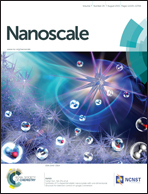Soft landing of bare PtRu nanoparticles for electrochemical reduction of oxygen
Abstract
Magnetron sputtering of two independent Pt and Ru targets coupled with inert gas aggregation in a modified commercial source has been combined with soft landing of mass-selected ions to prepare bare 4.5 nm diameter PtRu nanoparticles on glassy carbon electrodes with controlled size and morphology for electrochemical reduction of oxygen in solution. Employing atomic force microscopy (AFM) it is shown that the nanoparticles bind randomly to the glassy carbon electrode at a relatively low coverage of 7 × 104 ions μm−2 and that their average height is centered at 4.5 nm. Scanning transmission electron microscopy images obtained in the high-angle annular dark field mode (HAADF-STEM) further confirm that the soft-landed PtRu nanoparticles are uniform in size. Wide-area scans of the electrodes using X-ray photoelectron spectroscopy (XPS) reveal the presence of both Pt and Ru in atomic concentrations of ∼9% and ∼33%, respectively. Deconvolution of the high energy resolution XPS spectra in the Pt 4f and Ru 3d regions indicates the presence of both oxidized Pt and Ru. The substantially higher loading of Ru compared to Pt and enrichment of Pt at the surface of the nanoparticles is confirmed by wide-area analysis of the electrodes using time-of-flight medium energy ion scattering (TOF-MEIS) employing both 80 keV He+ and O+ ions. The activity of electrodes containing 7 × 104 ions μm−2 of bare 4.5 nm PtRu nanoparticles toward the electrochemical reduction of oxygen was evaluated employing cyclic voltammetry (CV) in 0.1 M HClO4 and 0.5 M H2SO4 solutions. In both electrolytes a pronounced reduction peak was observed during O2 purging of the solution that was not evident during purging with Ar. Repeated electrochemical cycling of the electrodes revealed little evolution in the shape or position of the voltammograms indicating high stability of the nanoparticles supported on glassy carbon. The reproducibility of the nanoparticle synthesis and deposition was evaluated by employing the same experimental parameters to prepare nanoparticles on glassy carbon electrodes on three occasions separated by several days. Surfaces with almost identical electrochemical behavior were observed with CV, demonstrating the highly reproducible preparation of bare nanoparticles using physical synthesis in the gas-phase combined with soft landing of mass-selected ions.


 Please wait while we load your content...
Please wait while we load your content...